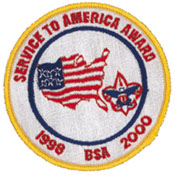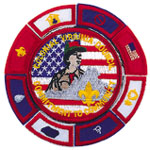![]() March-April 1999
March-April 1999
By Robert Peterson

Scores of Cub Scouts, Boy Scouts, and adult leaders in the Colonial Virginia Council marked last Sept. 19 by "fine-tooth combing" riverbanks and bay shores. The occasion was International Coastal Cleanup Day, and the Scouts and Scouters joined more than 300,000 conservation-minded people worldwide in gathering trash from waterways.
At the same time, they were doing their part for the Colonial Virginia Council's "Commitment to Community," part of a pledge by the Boy Scouts of America to contribute 200 million hours of community service nationwide by the end of the year 2000.
While Cub Scouts and Brownies looked for trash along the banks of the James River, den leader Pam Bowers said: "I think they're having a good time. I don't think they wanted to come at first, but they're enjoying it now." Her Cub Scouts belong to Pack 135, chartered to the Kingsmill, Va., Community Services Association.
About 60 children and adults from three packs, two Scout troops, and three Girl Scout units scoured six miles of the river and College Creek. They collected 350 pounds of debris under the leadership of Scoutmaster-Cubmaster Andy Priestley of Troop and Pack 414 of Our Savior's Lutheran Church in Norge, Va. He is a waterway's best friend, having cleaned up trash on the James River twice a year for nine years.
Bottles, cans, and food wrappers are the most visible debris along rivers, but in terms of numbers, cigarette butts lead the field, according to Katie Register, executive director of Clean Virginia Waterways. Her nonprofit organization coordinated the cleanup and provided bags for it.
"Cigarette butts are the leaders not only in Virginia but in the whole U.S.," she said. "They're plastic and have toxins that kill wildlife, so it's a real service to pick them up."
In Hampton, Va., 60 Scouts and adults from three troops and a pack combed the banks at two sites on the Hampton River. The project was suggested by the city's Clean Water Commission and approved by vote of the members in the local Order of the Arrow lodge.
"We work with the Clean Water Commission when we're looking for a service project," said Scoutmaster Roger Druin, who oversaw the work along the river in Ridgeway Park. His Scouts from Troop 10, chartered to Langley Christian Church in Hampton, were using canoes to get a close-up look at the banks.
The two Hampton River sites yielded 1,500 pounds of trash in just four hours of work. Scouts also found a sunken boat and submerged sofa, which they reported to the city.
While the river cleaners were at work, other Cub Scouts and Boy Scouts were doing Good Turns on drier land.
At St. Joseph's Roman Catholic Church in Hampton, Scouts from Troop 218 helped out at the church's community carnival. They set up booths, manned the concession stand, and assisted with games. "Wherever we can help, we help," Scoutmaster Mike Stearn said.
Troop 218 dotes on service, he added. In the last year, the troop performed 2,000 hours of community service, including a food drive for the church's pantry, regular visits to a nursing home, training sessions in camping skills for two Girl Scout troops, and a whitewater canoe trip in western Virginia for 16 at-risk youths.
In Newport News, members of Troop 777 and Pack 777 of Gethsemane Baptist Church were mowing grass and cleaning the yard at the home of Sandra Morris, who is disabled.
"This will be a continuing project for us," said Allen Pierce, who serves as both Scoutmaster and Cubmaster. "They're happy to do the work, because they know that they are not only doing it for the homeowner, for themselves, and for the troop, but they're also doing it for God."
Sandra Morris was also happy with the effort as she watched the Scouts at work. "They're great!" she exclaimed. "They're welcome back anytime."
Meanwhile, at a city park, nine Scouts and four adult leaders were directing parking and helping with games at the annual picnic of employees at Newport News Shipbuilding. The boys were from the Warwick Assembly of God Church's Troop 303. "Our Scouts like to do community service," said assistant Scoutmaster Steve Gray. "They always ask for more."
That spirit seems to pervade the Colonial Virginia Council. In the first seven months of the council's "Commitment to Community," its members performed 26,800 hours of service, with the pace accelerating as the end of 1998 neared.
The council got off to a running start as soon as the outcome of "The Presidents' Summit for America's Future" was announced in the spring of 1997. The national gathering of volunteer organizations, agencies, corporations, and citizens' groups was called to promote volunteer service by young people. The Boy Scouts of America announced a pledge of 200 million hours of Good Turns by its youth members through the year 2000.
Bill Spence, vice president of program, and Herb Smith, adviser for the Wahunsenakah Lodge of the Order of the Arrow, headed up the council's effort as Scouters considered how best to promote service.
They decided on eight categories: crime prevention, basic survival (including the annual Scouting for Food drive), conservation/environment, citizenship, abuse/prevention, service to the elderly, education, and a general community service area.
The effort, which was funded by an anonymous donor, included council patches for youths and adults who do at least two hours of service in one of the categories. For each category there is also an additional rim segment, or "rocker," to add to the outer edge of the main patch.

According to Herb Smith, some Scouters said: "'We're already doing community service; why should we get recognition for what we're already doing?' But their boys said, 'Hey, we want the patch!'"
A wide range of projects has come out of Commitment to Community. By last September more than 3,000 patches had been earned.
Conservation projects lead the field, with more than 1,800 rockers awarded. Bill Spence predicted that by September of this year, 75 percent of the council's 250 packs, troops, and crews will be sporting patches.
On the national level, Order of the Arrow lodges were asked to assume responsibility for promoting and publicizing the BSA commitment to America's Promise within each council. In the Colonial Virginia Council, the OA performed this task as if its members had written the book - encouraging units to undertake projects, offering ideas for them, and monitoring the results.
"We joined forces with the council right from the very beginning," OA adviser Herb Smith said.
And what could be more appropriate? The Order of the Arrow is, after all, the brotherhood of cheerful service.
Contributing editor Robert Peterson lives in Ramsey, N.J.
The BSA Pledge of ServiceThe Colonial Virginia Council's "Commitment to Community" is the council's special way of fulfilling its part of the pledge to the nation by the Boy Scouts of America to give 200 million hours of service by the end of the year 2000. The BSA made the promise in 1997 at the Presidents' Summit on America's Future, which was led by Presidents Clinton, Bush, Carter, and Ford, and chaired by Gen. Colin Powell. Attending were representatives of corporations, civic groups, and youth organizations. Five goals were set: matching at-risk youth with mentors, setting up safe after-school activities, ensuring health care for poor kids, providing education in marketable skills, and offering youth ways to serve their communities. The effort to carry out the summit's goals is being conducted by America's Promise, an organization headed by General Powell. The BSA is focusing on the fifth goal of America's Promise - community service. Any youth member of the BSA who does at least 12 hours of
community service per year and presents a Youth Commitment Form signed by a unit
The patch (Supply No. 339) is shown at right. It costs $1.99 and is available at Scout distributors and local council service centers. If 75 percent of the youth in a pack, troop, or crew are eligible for the patch, so are the unit's adult leaders. Unit leaders can record their members' community service on this year's Unit Charter Renewal Application, or on a Unit Commitment Form, available at the council service center. Completed forms should be sent back to the service center. |
Scout Community Service Efforts Take Many Different FormsIn BSA councils across the country, Cub Scouts, Boy Scouts, and Venturers are participating in special service projects to help the community. Below are a few examples: The New Orleans Area Council expects to have 300 community service projects requiring 1.8 million hours of work in the three years through the year 2000. The effort was kicked off at a Good Turn Scout Fair in the Louisiana Superdome last May. The kickoff included a food collection for the Second Harvesters Food Bank, a clothing collection for Goodwill Industries, and a blood drive for the Blood Center of Southeast Louisiana. In the Minneapolis-based Viking Council, at-risk teen-agers who have had trouble with the law are being diverted from the justice system into Venturing crews in a program called Juvenile Diversion. Each of seven crews comprises 15 to 20 kids from 14 to 17 years old who have committed such misdemeanors as shoplifting and vandalism. The crews meet twice a month for community service and learning new skills. To graduate and erase a police record, a Venturer must perform at least 16 hours of community service and meet other requirements. "We try to hook them up with community service they're going to like," said associate Advisor Jennifer McDonell of the crew in Brooklyn Park, a Minneapolis suburb. "We want them to do things that will help them grow a little bit," she said. Some volunteer at nursing homes. Others are assigned to after-school programs for younger children, "basically just being big brothers to them," McDonell said. Still others have volunteered at YMCAs and soup kitchens. Bob Reid of the council staff heads the Juvenile Diversion Program. "I came from the Mid-America Council in Omaha where the concept started," he explained, "and our recidivism rate was only 12 to 15 percent, compared with the court's rate of 60 to 70 percent." The program was funded by several companies, including Jen McDonell's Varitronic Systems, a division of the Brady Corp., Milwaukee. Scouting for Food, which became a BSA National Good Turn, was born in 1985 in the Greater St. Louis Area Council. The enthusiasm for it is as high as ever, according to Bill Frein, an assistant district commissioner who is participation chairman for Scouting for Food in the Gravois Trail District. "We start promoting the collection, which we run in November, at roundtables in August," Bill Frein said. "By the end of September, my co-chairman and I get on the phone and call every unit leader whose unit has not signed up." The personal touch works. Every one of the 130 units in the Gravois Trail District took part in the 1998 campaign, gathering 281,540 cans of food for the central food bank in St. Louis. The council as a whole collected more than 1.9 million cans. - R.P. |
Special Service Opportunities for Scouts Are Available in U.S. National Park SystemScouts who complete a minimum of 12 hours of work in a national park will receive both a BSA "Service to America" patch and a national park patch. Projects vary from park to park. All will be supervised by an adult Scout leader and coordinated through park personnel. To locate park sites by state, visit the National Park Service Web site at http://www.servicetoamerica.org/ and click on "Visit your parks," then "Find a park ... by state map." Contact the park(s) of your choice, ask for the Volunteers in Parks (VIP) coordinator, then inquire about park projects. (VIP coordinators and projects may also soon be listed on the Park Service Web site.) |
| The Boy Scouts of America | http://www.scouting.org |